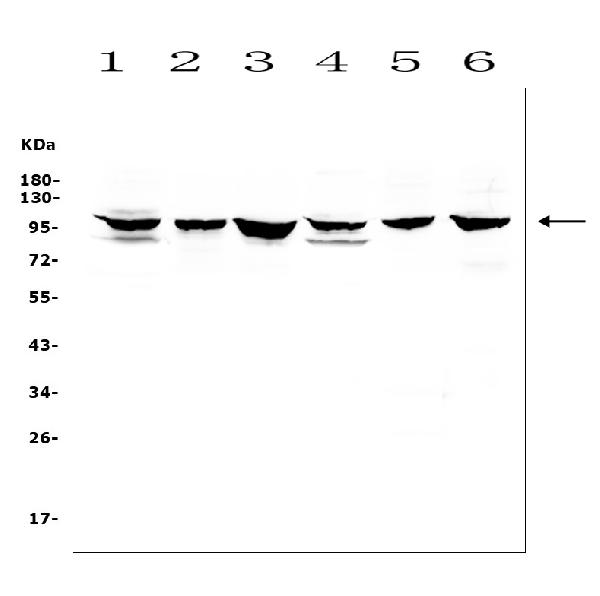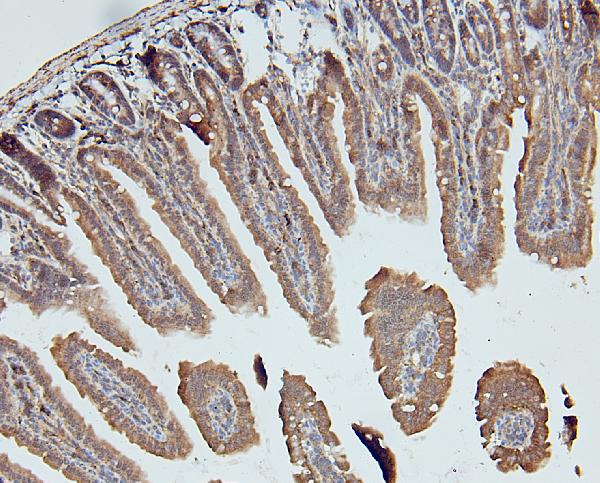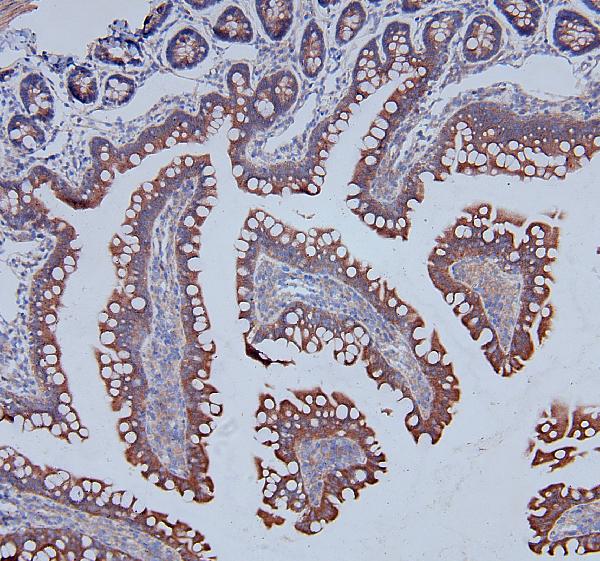Product Info Summary
| SKU: | A00905 |
|---|---|
| Size: | 100 μg/vial |
| Reactive Species: | Human, Mouse, Rat |
| Host: | Rabbit |
| Application: | ELISA, Flow Cytometry, IF, IHC, ICC, WB |
Customers Who Bought This Also Bought
Product info
Product Name
Anti-MCK10/NEP/DDR1 Antibody Picoband®
SKU/Catalog Number
A00905
Size
100 μg/vial
Form
Lyophilized
Description
Boster Bio Anti-MCK10/NEP/DDR1 Antibody Picoband® catalog # A00905. Tested in ELISA, Flow Cytometry, IF, IHC, ICC, WB applications. This antibody reacts with Human, Mouse, Rat. The brand Picoband indicates this is a premium antibody that guarantees superior quality, high affinity, and strong signals with minimal background in Western blot applications. Only our best-performing antibodies are designated as Picoband, ensuring unmatched performance.
Storage & Handling
Store at -20˚C for one year from date of receipt. After reconstitution, at 4˚C for one month. It can also be aliquotted and stored frozen at -20˚C for six months. Avoid repeated freeze-thaw cycles.
Cite This Product
Anti-MCK10/NEP/DDR1 Antibody Picoband® (Boster Biological Technology, Pleasanton CA, USA, Catalog # A00905)
Host
Rabbit
Contents
Each vial contains 4mg Trehalose, 0.9mg NaCl, 0.2mg Na2HPO4, 0.01mg NaN3.
Clonality
Polyclonal
Isotype
Rabbit IgG
Immunogen
E.coli-derived human MCK10/NEP/DDR1 recombinant protein (Position: R341-A909).
*Blocking peptide can be purchased. Costs vary based on immunogen length. Contact us for pricing.
Cross-reactivity
No cross-reactivity with other proteins.
Reactive Species
A00905 is reactive to DDR1 in Human, Mouse, Rat
Reconstitution
Add 0.2ml of distilled water will yield a concentration of 500ug/ml.
Observed Molecular Weight
101 kDa
Calculated molecular weight
101.128kDa
Background of DDR1
DDR1 (Discoidin domain receptor family, member 1) also known as NEP, EDDR1, NTRK4, TRKE, DDR, CAK or RTK6, is a human gene. The protein encoded by this gene is a RTK that is widely expressed in normal and transformed epithelial cells and is activated by various types of collagen.This protein belongs to a subfamily of tyrosine kinase receptors with a homology region to the Dictyostelium discoideum protein discoidin I in their extracellular domain.The DDR1 gene is mapped on 6p21.33. The fibrillar collagens and immobilized collagen activatedDDR1receptor phosphorylation after prolonged treatment. Bhatt et al. (2000)showed thatDdr1was highly expressed in the cerebellum of developing and adult mouse brain, and that bothDdr1and collagen IV were highly expressed in the pial layer of the cerebellar cortex.Cocultures of collagen I- and IV-expressing mouse pial cells withDdr1-expressing granule cells resulted in granule cell neurite extension. Inhibition of collagen-Ddr1signaling reduced granule cell neurite elongation.
Antibody Validation
Boster validates all antibodies on WB, IHC, ICC, Immunofluorescence, and ELISA with known positive control and negative samples to ensure specificity and high affinity, including thorough antibody incubations.
Application & Images
Applications
A00905 is guaranteed for ELISA, Flow Cytometry, IF, IHC, ICC, WB Boster Guarantee
Assay Dilutions Recommendation
The recommendations below provide a starting point for assay optimization. The actual working concentration varies and should be decided by the user.
Western blot, 0.25-0.5μg/ml, Human, Mouse, Rat
Immunohistochemistry (Paraffin-embedded Section), 0.5-1μg/ml, Human, Mouse, Rat, By Heat
Immunocytochemistry/Immunofluorescence, 2μg/ml, Human
Flow Cytometry (Fixed), 1-3μg/1x106 cells, Human
Flow Cytometry (Fixed), 1-3μg/1x106 cells, Human
ELISA, 0.1-0.5μg/ml, -
Positive Control
WB: human placenta tissue, human A549 whole cell, human K562 whole cell, human HepG2 whole cell, human PC-3 whole cell, human THP-1 whole cell, rat brain tissue, rat lung tissue, rat testicular tissue, mouse brain tissue, mouse lung tissue, mouse testicular tissue
IHC: mouse intestine tissue, rat intestine tissue, human Lung cancer tissue, human mammary cancer tissue, human rectal cancer tissue
ICC/IF: A431 cell
FCM: A431 cell
Validation Images & Assay Conditions

Click image to see more details
Figure 1. Western blot analysis of DDR1 using anti-DDR1 antibody (A00905).
Electrophoresis was performed on a 5-20% SDS-PAGE gel at 70V (Stacking gel) / 90V (Resolving gel) for 2-3 hours. The sample well of each lane was loaded with 50ug of sample under reducing conditions.
Lane 1: human placenta tissue lysates,
Lane 2: human A549 whole cell lysates,
Lane 3: human K562 whole cell lysates,
Lane 4: human HepG2 whole cell lysates,
Lane 5: human PC-3 whole cell lysates,
Lane 6: human THP-1 whole cell lysates.
After Electrophoresis, proteins were transferred to a Nitrocellulose membrane at 150mA for 50-90 minutes. Blocked the membrane with 5% Non-fat Milk/ TBS for 1.5 hour at RT. The membrane was incubated with rabbit anti-DDR1 antigen affinity purified polyclonal antibody (Catalog # A00905) at 0.5 μg/mL overnight at 4°C, then washed with TBS-0.1%Tween 3 times with 5 minutes each and probed with a goat anti-rabbit IgG-HRP secondary antibody at a dilution of 1:10000 for 1.5 hour at RT. The signal is developed using an Enhanced Chemiluminescent detection (ECL) kit (Catalog # EK1002) with Tanon 5200 system. A specific band was detected for DDR1 at approximately 101KD. The expected band size for DDR1 is at 101KD.

Click image to see more details
Figure 2. Western blot analysis of DDR1 using anti-DDR1 antibody (A00905).
Electrophoresis was performed on a 5-20% SDS-PAGE gel at 70V (Stacking gel) / 90V (Resolving gel) for 2-3 hours. The sample well of each lane was loaded with 50ug of sample under reducing conditions.
Lane 1: rat brain tissue lysates,
Lane 2: rat lung tissue lysates,
Lane 3: rat testicular tissue lysates,
Lane 4: mouse brain tissue lysates,
Lane 5: mouse lung tissue lysates,
Lane 6: mouse testicular tissue lysates.
After Electrophoresis, proteins were transferred to a Nitrocellulose membrane at 150mA for 50-90 minutes. Blocked the membrane with 5% Non-fat Milk/ TBS for 1.5 hour at RT. The membrane was incubated with rabbit anti-DDR1 antigen affinity purified polyclonal antibody (Catalog # A00905) at 0.5 μg/mL overnight at 4°C, then washed with TBS-0.1%Tween 3 times with 5 minutes each and probed with a goat anti-rabbit IgG-HRP secondary antibody at a dilution of 1:10000 for 1.5 hour at RT. The signal is developed using an Enhanced Chemiluminescent detection (ECL) kit (Catalog # EK1002) with Tanon 5200 system. A specific band was detected for DDR1 at approximately 101KD. The expected band size for DDR1 is at 101KD.

Click image to see more details
Figure 3. IHC analysis of DDR1 using anti-DDR1 antibody (A00905).
DDR1 was detected in paraffin-embedded section of mouse intestine tissues. Heat mediated antigen retrieval was performed in citrate buffer (pH6, epitope retrieval solution) for 20 mins. The tissue section was blocked with 10% goat serum. The tissue section was then incubated with 1μg/ml rabbit anti-DDR1 Antibody (A00905) overnight at 4°C. Biotinylated goat anti-rabbit IgG was used as secondary antibody and incubated for 30 minutes at 37°C. The tissue section was developed using Strepavidin-Biotin-Complex (SABC)(Catalog # SA1022) with DAB as the chromogen.

Click image to see more details
Figure 4. IHC analysis of DDR1 using anti-DDR1 antibody (A00905).
DDR1 was detected in paraffin-embedded section of rat intestine tissues. Heat mediated antigen retrieval was performed in citrate buffer (pH6, epitope retrieval solution) for 20 mins. The tissue section was blocked with 10% goat serum. The tissue section was then incubated with 1μg/ml rabbit anti-DDR1 Antibody (A00905) overnight at 4°C. Biotinylated goat anti-rabbit IgG was used as secondary antibody and incubated for 30 minutes at 37°C. The tissue section was developed using Strepavidin-Biotin-Complex (SABC)(Catalog # SA1022) with DAB as the chromogen.

Click image to see more details
Figure 5. IHC analysis of DDR1 using anti-DDR1 antibody (A00905).
DDR1 was detected in paraffin-embedded section of human Lung cancer tissues. Heat mediated antigen retrieval was performed in citrate buffer (pH6, epitope retrieval solution) for 20 mins. The tissue section was blocked with 10% goat serum. The tissue section was then incubated with 1μg/ml rabbit anti-DDR1 Antibody (A00905) overnight at 4°C. Biotinylated goat anti-rabbit IgG was used as secondary antibody and incubated for 30 minutes at 37°C. The tissue section was developed using Strepavidin-Biotin-Complex (SABC)(Catalog # SA1022) with DAB as the chromogen.

Click image to see more details
Figure 6. IHC analysis of DDR1 using anti-DDR1 antibody (A00905).
DDR1 was detected in paraffin-embedded section of human mammary cancer tissues. Heat mediated antigen retrieval was performed in citrate buffer (pH6, epitope retrieval solution) for 20 mins. The tissue section was blocked with 10% goat serum. The tissue section was then incubated with 1μg/ml rabbit anti-DDR1 Antibody (A00905) overnight at 4°C. Biotinylated goat anti-rabbit IgG was used as secondary antibody and incubated for 30 minutes at 37°C. The tissue section was developed using Strepavidin-Biotin-Complex (SABC)(Catalog # SA1022) with DAB as the chromogen.

Click image to see more details
Figure 7. IHC analysis of DDR1 using anti-DDR1 antibody (A00905).
DDR1 was detected in paraffin-embedded section of human rectal cancer tissues. Heat mediated antigen retrieval was performed in citrate buffer (pH6, epitope retrieval solution) for 20 mins. The tissue section was blocked with 10% goat serum. The tissue section was then incubated with 1μg/ml rabbit anti-DDR1 Antibody (A00905) overnight at 4°C. Biotinylated goat anti-rabbit IgG was used as secondary antibody and incubated for 30 minutes at 37°C. The tissue section was developed using Strepavidin-Biotin-Complex (SABC)(Catalog # SA1022) with DAB as the chromogen.

Click image to see more details
Figure 8. Flow Cytometry analysis of A431 cells using anti-DDR1 antibody (A00905).
Overlay histogram showing A431 cells stained with A00905 (Blue line). To facilitate intracellular staining, cells were fixed with 4% paraformaldehyde and permeabilized with permeabilization buffer. The cells were blocked with 10% normal goat serum. And then incubated with rabbit anti-DDR1 Antibody (A00905,1μg/1x106 cells) for 30 min at 20°C. DyLight®488 conjugated goat anti-rabbit IgG (BA1127, 5-10μg/1x106 cells) was used as secondary antibody for 30 minutes at 20°C. Isotype control antibody (Green line) was rabbit IgG (1μg/1x106) used under the same conditions. Unlabelled sample without incubation with primary antibody and secondary antibody (Red line) was used as a blank control.

Click image to see more details
Figure 9. IF analysis of DDR1 using anti-DDR1 antibody (A00905).
DDR1 was detected in immunocytochemical section of A431 cells. Enzyme antigen retrieval was performed using IHC enzyme antigen retrieval reagent (AR0022) for 15 mins. The cells were blocked with 10% goat serum. And then incubated with 2μg/mL rabbit anti-DDR1 Antibody (A00905) overnight at 4°C. DyLight®488 Conjugated Goat Anti-Rabbit IgG (BA1127) was used as secondary antibody at 1:100 dilution and incubated for 30 minutes at 37°C. The section was counterstained with DAPI. Visualize using a fluorescence microscope and filter sets appropriate for the label used.
Protein Target Info & Infographic
Gene/Protein Information For DDR1 (Source: Uniprot.org, NCBI)
Gene Name
DDR1
Full Name
Epithelial discoidin domain-containing receptor 1
Weight
101.128kDa
Superfamily
protein kinase superfamily
Alternative Names
Epithelial discoidin domain-containing receptor 1; Epithelial discoidin domain receptor 1; CD167 antigen-like family member A; Cell adhesion kinase; Discoidin receptor tyrosine kinase; HGK2; Mammary carcinoma kinase 10; MCK-10; Protein-tyrosine kinase 3A; Protein-tyrosine kinase RTK-6; TRK E; Tyrosine kinase DDR; Tyrosine-protein kinase CAK; CD167a; DDR1; CAK, EDDR1, NEP, NTRK4, PTK3A, RTK6, TRKE DDR1 CAK, CD167, DDR, EDDR1, HGK2, MCK10, NEP, NTRK4, PTK3, PTK3A, RTK6, TRKE discoidin domain receptor tyrosine kinase 1 epithelial discoidin domain-containing receptor 1|CD167 -like family member A|PTK3A protein tyrosine kinase 3A|cell adhesion kinase|mammary carcinoma kinase 10|neuroepithelial tyrosine kinase|neurotrophic tyrosine kinase, receptor, type 4|protein-tyrosine kinase RTK-6|tyrosine kinase DDR|tyrosine-protein kinase CAK
*If product is indicated to react with multiple species, protein info is based on the gene entry specified above in "Species".For more info on DDR1, check out the DDR1 Infographic

We have 30,000+ of these available, one for each gene! Check them out.
In this infographic, you will see the following information for DDR1: database IDs, superfamily, protein function, synonyms, molecular weight, chromosomal locations, tissues of expression, subcellular locations, post-translational modifications, and related diseases, research areas & pathways. If you want to see more information included, or would like to contribute to it and be acknowledged, please contact [email protected].
Specific Publications For Anti-MCK10/NEP/DDR1 Antibody Picoband® (A00905)
Loading publications
Recommended Resources
Here are featured tools and databases that you might find useful.
- Boster's Pathways Library
- Protein Databases
- Bioscience Research Protocol Resources
- Data Processing & Analysis Software
- Photo Editing Software
- Scientific Literature Resources
- Research Paper Management Tools
- Molecular Biology Software
- Primer Design Tools
- Bioinformatics Tools
- Phylogenetic Tree Analysis
Customer Reviews
Have you used Anti-MCK10/NEP/DDR1 Antibody Picoband®?
Submit a review and receive an Amazon gift card.
- $30 for a review with an image
0 Reviews For Anti-MCK10/NEP/DDR1 Antibody Picoband®
Customer Q&As
Have a question?
Find answers in Q&As, reviews.
Can't find your answer?
Submit your question
5 Customer Q&As for Anti-MCK10/NEP/DDR1 Antibody Picoband®
Question
We are currently using anti-MCK10/NEP/DDR1 antibody A00905 for rat tissue, and we are well pleased with the IHC-P results. The species of reactivity given in the datasheet says human, mouse, rat. Is it possible that the antibody can work on monkey tissues as well?
Verified Customer
Verified customer
Asked: 2019-11-29
Answer
The anti-MCK10/NEP/DDR1 antibody (A00905) has not been validated for cross reactivity specifically with monkey tissues, but there is a good chance of cross reactivity. We have an innovator award program that if you test this antibody and show it works in monkey you can get your next antibody for free. Please contact me if I can help you with anything.
Boster Scientific Support
Answered: 2019-11-29
Question
I would like using your anti-MCK10/NEP/DDR1 antibody for spreading of cells studies. Has this antibody been tested with western blotting on hepg2 whole cell lysates? We would like to see some validation images before ordering.
Verified Customer
Verified customer
Asked: 2018-12-04
Answer
Thank you for your inquiry. This A00905 anti-MCK10/NEP/DDR1 antibody is tested on human placenta tissue, a549 whole cell lysates, k562 whole cell lysates, hepg2 whole cell lysates, rat lung tissue, brain tissue, mouse lung tissue, a431 cells. It is guaranteed to work for ELISA, Flow Cytometry, IHC-P, WB in human, mouse, rat. Our Boster guarantee will cover your intended experiment even if the sample type has not been be directly tested.
Boster Scientific Support
Answered: 2018-12-04
Question
We have been able to see staining in rat corpus callosum. What should we do? Is anti-MCK10/NEP/DDR1 antibody supposed to stain corpus callosum positively?
F. Miller
Verified customer
Asked: 2018-06-25
Answer
Based on literature corpus callosum does express DDR1. Based on Uniprot.org, DDR1 is expressed in corpus callosum, brain keratinocyte, placenta, ovary, fetal liver, lung, brain placenta, brain, peripheral blood leukocyte, brain muscle, mammary carcinoma, melanocyte, among other tissues. Regarding which tissues have DDR1 expression, here are a few articles citing expression in various tissues:
Brain, and Keratinocyte, Pubmed ID: 8226977
Brain, and Muscle, Pubmed ID: 15489334
Fetal liver, Pubmed ID: 8302582
Mammary carcinoma, Pubmed ID: 7845687, 7834423
Melanocyte, Pubmed ID: 8247543, 9659899
Ovary, Pubmed ID: 7848919
Peripheral blood leukocyte, Pubmed ID: 16702430
Placenta, Pubmed ID: 8390675
Boster Scientific Support
Answered: 2018-06-25
Question
Our lab were satisfied with the WB result of your anti-MCK10/NEP/DDR1 antibody. However we have observed positive staining in corpus callosum isoform 1: cell membrane using this antibody. Is that expected? Could you tell me where is DDR1 supposed to be expressed?
Verified Customer
Verified customer
Asked: 2017-10-23
Answer
Based on literature, corpus callosum does express DDR1. Generally DDR1 expresses in isoform 1: cell membrane. Regarding which tissues have DDR1 expression, here are a few articles citing expression in various tissues:
Brain, and Keratinocyte, Pubmed ID: 8226977
Brain, and Muscle, Pubmed ID: 15489334
Fetal liver, Pubmed ID: 8302582
Mammary carcinoma, Pubmed ID: 7845687, 7834423
Melanocyte, Pubmed ID: 8247543, 9659899
Ovary, Pubmed ID: 7848919
Peripheral blood leukocyte, Pubmed ID: 16702430
Placenta, Pubmed ID: 8390675
Boster Scientific Support
Answered: 2017-10-23
Question
We have tried in the past anti-MCK10/NEP/DDR1 antibody for IHC-P on fetal liver in a previous project. I am using mouse, and We want to use the antibody for WB next. We need examining fetal liver as well as corpus callosum in our next experiment. Could you please give me some suggestion on which antibody would work the best for WB?
K. Jackson
Verified customer
Asked: 2017-01-30
Answer
I looked at the website and datasheets of our anti-MCK10/NEP/DDR1 antibody and it appears that A00905 has been validated on mouse in both IHC-P and WB. Thus A00905 should work for your application. Our Boster satisfaction guarantee will cover this product for WB in mouse even if the specific tissue type has not been validated. We do have a comprehensive range of products for WB detection and you can check out our website bosterbio.com to find out more information about them.
Boster Scientific Support
Answered: 2017-01-30





